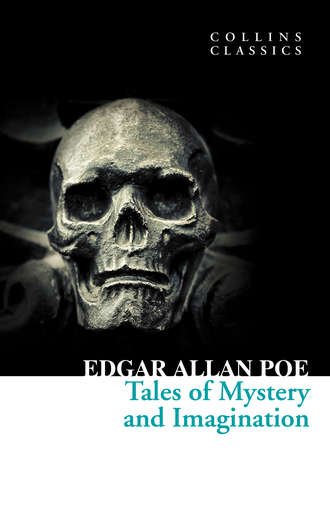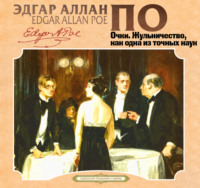
Полная версия
Tales of Mystery and Imagination
‘While I was busied in reflection, my eyes fell upon a narrow ledge in the eastern face of the rock, perhaps a yard below the summit upon which I stood. This ledge projected about eighteen inches, and was not more than a foot wide, while a niche in the cliff just above it gave it a rude resemblance to one of the hollow-backed chairs used by our ancestors. I made no doubt that here was the “devil’s seat” alluded to in the MS., and now I seemed to grasp the full secret of the riddle.
‘The “good glass,” I knew, could have reference to nothing but a telescope; for the word “glass” is rarely employed in any other sense by seamen. Now here, I at once saw, was a telescope to be used, and a definite point of view, admitting no variation, from which to use it. Nor did I hesitate to believe that the phrases, “forty-one degrees and thirteen minutes,” and, “north-east and by north,” were intended as directions for the levelling of the glass. Greatly excited by these discoveries, I hurried home, procured a telescope, and returned to the rock.
‘I let myself down to the ledge, and found that it was impossible to retain a seat upon it except in one particular position. This fact confirmed my preconceived idea. I proceeded to use the glass. Of course, the “forty-one degrees and thirteen minutes” could allude to nothing but elevation above the visible horizon, since the horizontal direction was clearly indicated by the words, “north-east and by north.” This latter direction I at once established by means of a pocket-compass; then, pointing the glass as nearly at an angle of forty-one degrees of elevation as I could do it by guess, I moved it cautiously up or down, until my attention was arrested by a circular rift or opening in the foliage of a large tree that overtopped its fellows in the distance. In the centre of this rift I perceived a white spot, but could not, at first, distinguish what it was. Adjusting the focus of the telescope, I again looked, and now made it out to be a human skull.
‘Upon this discovery I was so sanguine as to consider the enigma solved; for the phrase “main branch, seventh limb, east side,” could refer only to the position of the skull upon the tree, while “shoot from the left eye of the death’s-head” admitted, also, of but one interpretation, in regard to a search for buried treasure. I perceived that the design was to drop a bullet from the left eye of the skull, and that a bee-line, or, in other words, a straight line, drawn from the nearest point of the trunk through “the shot” (or the spot where the bullet fell), and thence extended to a distance of fifty feet, would indicate a definite point—and beneath this point I thought it at least possible that a deposit of value lay concealed.’
‘All this,’ I said, ‘is exceedingly clear, and, although ingenious, still simple and explicit. When you left the Bishop’s Hotel, what then?’
‘Why, having carefully taken the bearings of the tree, I turned homeward. The instant that I left “the devil’s seat,” however, the circular rift vanished; nor could I get a glimpse of it afterward, turn as I would. What seems to me the chief ingenuity in this whole business, is the fact (for repeated experiment has convinced me it is a fact) that the circular opening in question is visible from no other attainable point of view than that afforded by the narrow ledge upon the face of the rock.
‘In this expedition to the “Bishop’s Hotel” I had been attended by Jupiter, who had, no doubt, observed for some weeks past, the abstraction of my demeanour, and took especial care not to leave me alone. But, on the next day, getting up very early, I contrived to give him the slip, and went into the hills in search of the tree. After much toil I found it. When I came home at night my valet proposed to give me a flogging. With the rest of the adventure I believe you are as well acquainted as myself.’
‘I suppose,’ said I, ‘you missed the spot, in the first attempt at digging, through Jupiter’s stupidity in letting the bug fall through the right instead of through the left eye of the skull.’
‘Precisely. This mistake made a difference of about two inches and a half in the “shot”—that is to say, in the position of the peg nearest the tree; and had the treasure been beneath the “shot” the error would have been of little moment; but the “shot,” together with the nearest point of the tree, were merely two points for the establishment of a line of direction; of course the error, however trivial in the beginning, increased as we proceeded with the line, and by the time we had gone fifty feet threw us quite off the scent. But my deep-seated impressions that treasure was here somewhere actually buried, we might have had all our labour in vain.’
‘But your grandiloquence, and your conduct in swinging the beetle—how excessively odd! I was sure you were mad. And why did you insist upon letting fall the bug, instead of a bullet, from the skull?’
‘Why, to be frank, I felt somewhat annoyed by your evident suspicions touching my sanity, and so resolved to punish you quietly, in my own way, by a little bit of sober mystification. For this reason I swung the beetle, and for this reason I let it fall from the tree. An observation of yours about its great weight suggested the latter idea.’
‘Yes, I perceive; and now there is only one point which puzzles me. What are we to make of the skeletons found in the hole?’
‘That is a question I am no more able to answer than yourself. There seems, however, only one plausible way of accounting for them—and yet it is dreadful to believe in such atrocity as my suggestion would imply. It is clear that Kidd—if Kidd indeed secreted this treasure, which I doubt not—it is clear that he must have had assistance in the labour. But this labour concluded, he may have thought it expedient to remove all participants in his secret. Perhaps a couple of blows with a mattock were sufficient, while his coadjutors were busy in the pit; perhaps it required a dozen—who shall tell?’
CHAPTER 2 The Balloon Hoax
[Astounding News by Express, via Norfolk!—The Atlantic Crossed in Three Days! Signal Triumph of Mr Monck Mason’s Flying Machine!—Arrival at Sullivan’s Island, near Charleston, S.C., of Mr Mason, Mr Robert Holland, Mr Henson, Mr Harrison Ainsworth, and four others, in the Steering Balloon, Victoria, after a passage of seventy-five hours from Land to Land! Full Particulars of the Voyage!
The subjoined jeu d’esprit, with the preceding heading in magnificent capitals, well interspersed with notes of admiration, was originally published, as matter of fact, in the New York Sun, a daily newspaper, and therein fully subserved the purpose of creating indigestible aliment for the quidnuncs during the few hours intervening between a couple of Charleston mails. The rush for the ‘sole paper which had the news,’ was something beyond even the prodigious; and, in fact, if (as some assert) the Victoria did not absolutely accomplish the voyage recorded, it will be difficult to assign a reason why she should not have accomplished it.
The great problem is at length solved! The air, as well as the earth and the ocean, has been subdued by science, and will become a common and convenient highway for mankind. The Atlantic has been actually crossed in a Balloon! and this too without difficulty—without any great apparent danger—with thorough control of the machine—and in the inconceivably brief period of seventy-five hours from shore to shore! By the energy of an agent at Charleston, S.C., we are enabled to be the first to furnish the public with a detailed account of this most extraordinary voyage, which was performed between Saturday, the 6th instant, at 11 a.m., and 2 p.m., on Tuesday, the 9th instant, by Sir Everard Bringhurst; Mr Osborne, a nephew of Lord Bentinck’s; Mr Monck Mason and Mr Robert Holland, the well-known aeronauts; Mr Harrison Ainsworth, author of Jack Sheppard, etc.; and Mr Henson, the projector of the late unsuccessful flying machine, with two seamen from Woolwich; in all, eight persons. The particulars furnished below may be relied on as authentic and accurate in every respect, as, with a slight exception, they are copied verbatim from the joint diaries of Mr Monck Mason and Mr Harrison Ainsworth, to whose politeness our agent is indebted for much verbal information respecting the balloon itself, its construction, and other matters of interest. The only alteration in the MS. received has been made for the purpose of throwing the hurried account of our agent, Mr Forsyth, into a connected and intelligible form.
The Balloon
‘Two very decided failures of late,—those of Mr Henson and Sir George Cayley,—had much weakened the public interest in the subject of aerial navigation. Mr Henson’s scheme (which at first was considered very feasible even by men of science) was founded upon the principle of an inclined plane, started from an eminence by an extrinsic force applied and continued by the revolution of impinging vanes in form and number resembling the vanes of a windmill. But in all the experiments made with models at the Adelaide Gallery, it was found that the operation of these fans not only did not propel the machine, but actually impeded its flight. The only propelling force it ever exhibited was the mere impetus acquired from the descent of the inclined plane; and this impetus carried the machine farther when the vanes were at rest than when they were in motion—a fact which sufficiently demonstrates their inutility; and in the absence of the propelling, which was also the sustaining power, the whole fabric would necessarily descend. This consideration led Sir George Cayley to think only of adapting a propeller to some machine having of itself an independent power of support—in a word, to a balloon; the idea however, being novel, or original with Sir George, only so far as regards the mode of its application to practice. He exhibited a model of his invention at the Polytechnic Institution. The propelling principle, or power, was here, also, applied to interrupted surfaces, or vanes, put in revolution. These vanes were four in number, but were found entirely ineffectual in moving the balloon, or in aiding its ascending power. The whole project was thus a complete failure.
‘It was at this juncture that Mr Monck Mason (whose voyage from Dover to Weilburg in the balloon, Nassau, occasioned so much excitement in 1837) conceived the idea of employing the principle of the Archimedian screw for the purpose of propulsion through the air—rightly attributing the failure of Mr Henson’s scheme, and of Sir George Cayley’s, to the interruption of surface in the independent vanes. He made the first public experiment at Willis’s Rooms, but afterward removed his model to the Adelaide Gallery.
‘Like Sir George Cayley’s balloon, his own was an ellipsoid. Its length was thirteen feet six inches—height, six feet eight inches. It contained about three hundred and twenty cubic feet of gas, which, if pure hydrogen, would support twenty-one pounds upon its first inflation, before the gas has time to deteriorate or escape. The weight of the whole machine and apparatus was seventeen pounds—leaving about four pounds to spare. Beneath the centre of the balloon was a frame of light wood, about nine feet long, and rigged on to the balloon itself with a network in the customary manner. From this framework was suspended a wicker basket or car.
‘The screw consists of an axis of hollow brass tube, eighteen inches in length, through which, upon a semi-spiral inclined at fifteen degrees, pass a series of steel-wire radii, two feet long, and thus projecting a foot on either side. These radii are connected at the outer extremities by two bands of flattened wire, the whole in this manner forming the framework of the screw, which is completed by a covering of oiled silk cut into gores, and tightened so as to present a tolerably uniform surface. At each end of its axis this screw is supported by pillars of hollow brass tube descending from the hoop. In the lower ends of these tubes are holes in which the pivots of the axis revolve. From the end of the axis which is next to the car, proceeds a shaft of steel, connecting the screw with the pinion of a piece of spring machinery fixed in the car. By the operation of this spring, the screw is made to revolve with great rapidity, communicating a progressive motion to the whole. By means of the rudder, the machine was readily turned in any direction. The spring was of great power, compared with its dimensions, being capable of raising forty-five pounds upon a barrel of four inches diameter after the first turn, and gradually increasing as it was wound up. It weighed, altogether, eight pounds six ounces. The rudder was a light frame of cane covered with silk, shaped somewhat like a battledore, and was about three feet long, and at the widest, one foot. Its weight was about two ounces. It could be turned flat, and directed upward or downward, as well as to the right or left; and thus enabled the aeronaut to transfer the resistance of the air which in an inclined position must generate in its passage, to any side upon which he might desire to act; thus determining the balloon in the opposite direction.
‘This model (which, through want of time, we have necessarily described in an imperfect manner) was put in action at the Adelaide Gallery, where it accomplished a velocity of five miles per hour; although, strange to say, it excited very little interest in comparison with the previous complex machine of Mr Henson, so resolute is the world to despise anything which carries with it an air of simplicity. To accomplish the great desideratum of aerial navigation, it was very generally supposed that some exceedingly complicated application must be made of some unusually profound principle in dynamics.
‘So well satisfied, however, was Mr Mason of the ultimate success of his invention, that he determined to construct immediately, if possible, a balloon of sufficient capacity to test the question by a voyage of some extent—the original design being to cross the British Channel, as before, in the Nassau balloon. To carry out his views he solicited and obtained the patronage of Sir Everard Bringhurst and Mr Osborne, two gentlemen well known for scientific acquirement, and especially for the interest they have exhibited in the progress of aerostation. The project, at the desire of Mr Osborne, was kept a profound secret from the public, the only persons entrusted with the design being those actually engaged in the construction of the machine, which was built (under the superintendence of Mr Mason, Mr Holland, Sir Everard Bringhurst, and Mr Osborne) at the seat of the latter gentleman near Penstruthal, in Wales. Mr Henson, accompanied by his friend Mr Ainsworth, was admitted to a private view of the balloon on Saturday last, when the two gentlemen made final arrangements to be included in the adventure. We are not informed for what reason the two seamen were also included in the party, but, in the course of a day or two, we shall put our readers in possession of the minutest particulars respecting this extraordinary voyage.
‘The balloon is composed of silk, varnished with the liquid gum caoutchouc. It is of vast dimensions, containing more than 40,000 feet of gas; but as coal-gas was employed in place of the more expensive and inconvenient hydrogen, the supporting power of the machine, when fully inflated, and immediately after inflation, is not more than about 2500 pounds. The coal-gas is not only much less costly, but is easily procured and managed.
‘For its introduction into common use for purposes of aerostation we are indebted to Mr Charles Green. Up to his discovery the process of inflation was not only exceedingly expensive, but uncertain. Two and even three days have frequently been wasted in futile attempts to procure a sufficiency of hydrogen to fill a balloon, from which it had great tendency to escape, owing to its extreme subtlety, and its affinity for the surrounding atmosphere. In a balloon sufficiently perfect to retain its contents of coal-gas unaltered, in quality or amount, for six months, an equal quantity of hydrogen could not be maintained in equal purity for six weeks.
‘The supporting power being estimated at 2500 pounds, and the united weights of the party amounting only to about 1200, there was left a surplus of 1300, of which again 1200 was exhausted by ballast, arranged in bags of different sizes, with their respective weights marked upon them; by cordage, barometers, telescopes, barrels containing provision for a fortnight, water-casks, cloaks, carpet-bags, and various other indispensable matters, including a coffee-warmer, contrived for warming coffee by means of slack-lime, so as to dispense altogether with fire, if it should be judged prudent to do so. All these articles, with the exception of the ballast, and a few trifles, were suspended from the hoop overhead. The car is much smaller and lighter, in proportion, than the one appended to the model. It is formed of a light wicker, and is wonderfully strong, for so frail-looking a machine. Its rim is about four feet deep. The rudder is also much larger, in proportion, than that of the model; and the screw is considerably smaller. The balloon is furnished besides with a grapnel and a guide-rope, which latter is of the most indispensable importance. A few words, in explanation, will here be necessary for such of our readers as are not conversant with the details of aerostation.
‘As soon as the balloon quits the earth, it is subjected to the influence of many circumstances tending to create a difference in its weight; augmenting or diminishing its ascending power. For example, there may be a deposition of dew upon the silk, to the extent even of several hundred pounds; ballast has then to be thrown out, or the machine may descend. This ballast being discarded, and a clear sunshine evaporating the dew, and at the same time expanding the gas in the silk, the whole will again rapidly ascend. To check this ascent, the only resource is (or rather was, until Mr Green’s invention of the guide-rope) the permission of the escape of gas from the valve; but in the loss of gas is a proportionate general loss of ascending power; so that, in a comparatively brief period, the best-constructed balloon must necessarily exhaust all its resources, and come to the earth. This was the great obstacle to voyages of length.
‘The guide-rope remedies the difficulty in the simplest manner conceivable. It is merely a very long rope which is suffered to trail from the car, and the effect of which is to prevent the balloon from changing its level in any material degree. If, for example, there should be a deposition of moisture upon the silk, and the machine begins to descend in consequence, there will be no necessity for discharging ballast to remedy the increase of weight, for it is remedied, or counter acted, in an exactly just proportion, by the deposit on the ground of just so much of the end of the rope as is necessary. If, on the other hand, any circumstances should cause undue levity, and consequent ascent, this levity is immediately counteracted by the additional weight of rope upraised from the earth. Thus the balloon can neither ascend nor descend, except within very narrow limits, and its resources, either in gas or ballast, remain comparatively unimpaired. When passing over an expanse of water, it becomes necessary to employ kegs of copper or wood, filled with liquid ballast of a lighter nature than water. These float, and serve all the purposes of a mere rope on land. Another most important office of the guide-rope is to point out the direction of the balloon. The rope drags, either on land or sea, while the balloon is free; the latter, consequently, is always in advance, when any progress whatever is made: a comparison, therefore, by means of the compass, of the relative positions of the two objects will always indicate the course. In the same way, the angle formed by the rope with the vertical axis of the machine, indicated the velocity. When there is no angle—in other words, when the rope hangs perpendicularly, the whole apparatus is stationary; but the larger the angle, that is to say, the farther the balloon precedes the end of the rope, the greater the velocity; and the converse.
‘As the original design was to cross the British Channel, and alight as near Paris as possible, the voyagers had taken the precaution to prepare themselves with passports directed to all parts of the Continent, specifying the nature of the expedition, as in the case of the Nassau voyage, and entitling the adventurers to exemption from the usual formalities of office; unexpected events, however, rendered these passports superfluous.
‘The inflation was commenced very quietly at day-break, on Saturday morning, the 6th instant, in the courtyard of Weal-Vor House, Mr Osborne’s seat, about a mile from Penstruthal, in North Wales; and at seven minutes past eleven, everything being ready for departure, the balloon was set free, rising gently but steadily, in a direction nearly south, no use being made, for the first half-hour, of either the screw or the rudder. We proceed now with the journal, as transcribed by Mr Forsyth from the joint MSS. of Mr Monck Mason and Mr Ainsworth. The body of the journal, as given, is in the handwriting of Mr Mason, and a PS. is appended, each day, by Mr Ainsworth, who has in preparation, and will shortly give the public a more minute and, no doubt, a thrillingly interesting account of the voyage.
The Journal
‘Saturday, April the 6th.—Every preparation likely to embarrass us having been made overnight, we commenced the inflation this morning at daybreak; but owing to a thick fog, which encumbered the folds of the silk and rendered it unmanageable, we did not get through before nearly eleven o’clock. Cut loose, then, in high spirits, and rose gently but steadily, with a light breeze at north, which bore us in the direction of the Bristol Channel. Found the ascending force greater than we had expected; and as we arose higher and so got clear of the cliffs, and more in the sun’s rays, our ascent became very rapid. I did not wish, however, to lose gas at so early a period of the adventure, and so concluded to ascend for the present. We soon ran out our guide-rope; but even when we had raised it clear of the earth, we still went up very rapidly. The balloon was unusually steady, and looked beautiful. In about ten minutes after starting the barometer indicated an altitude of 15,000 feet. The weather was remarkably fine, and the view of the subjacent country—a most romantic one when seen from any point—was now especially sublime. The numerous deep gorges presented the appearance of lakes, on account of the dense vapours with which they were filled, and the pinnacles and crags to the south-east, piled in inextricable confusion, resembling nothing so much as the giant cities of Eastern fable. We were rapidly approaching the mountains in the south, but our elevation was more than sufficient to enable us to pass them in safety. In a few minutes we soared over them in fine style; and Mr Ainsworth, with the seamen, was surprised at their apparent want of altitude when viewed from the car, the tendency of great elevation in a balloon being to reduce inequalities of the surface below to nearly a dead level. At half-past eleven, still proceeding nearly south, we obtained our first view of the Bristol Channel; and, in fifteen minutes afterward, the line of breakers on the coast appeared immediately beneath us, and we were fairly out at sea. We now resolved to let off enough gas to bring our guide-rope, with the buoys affixed, into the water. This was immediately done, and we commenced a gradual descent. In about twenty minutes our first buoy dipped, and at the touch of the second soon afterward, we remained stationary as to elevation. We were all now anxious to test the efficiency of the rudder and screw, and we put them both into requisition forthwith, for the purpose of altering our direction more to the eastward and in a line for Paris. By means of the rudder we instantly effected the necessary change of direction, and our course was brought nearly at right angles to that of the wind; when we set in motion the spring of the screw, and were rejoiced to find it propel as readily as desired. Upon this we gave nine hearty cheers, and dropped in the sea a bottle, enclosing a slip of parchment with a brief account of the principle of the invention. Hardly, however, had we done with our rejoicings when an unforeseen accident occurred which discouraged us in no little degree. The steel rod connecting the spring with the propeller was suddenly jerked out of place, at the car end (by a swaying of the car through some movement of one of the two seamen we had taken up), and in an instant hung dangling out of reach from the pivot of the axis of the screw. While we were endeavouring to regain it, our attention being completely absorbed, we became involved in a strong current of wind from the east, which bore us, with rapidly increasing force, toward the Atlantic. We soon found ourselves driving out to sea at the rate of not less, certainly, than fifty or sixty miles an hour, so that we came up with Cape Clear, at some forty miles to our north, before we had secured the rod, and had time to think what we were about. It was now that Mr Ainsworth made an extraordinary, but, to my fancy, a by no means unreasonable or chimerical proposition, in which he was instantly seconded by Mr Holland, viz.: that we should take advantage of the strong gale which bore us on, and in place of beating back to Paris, make an attempt to reach the coast of North America. After slight reflection I gave a willing assent to this bold proposition, which, strange to say, met with objection from the two seamen only. As the stronger party, however, we overruled their fears, and kept resolutely upon our course. We steered due west; but as the trailing of the buoys materially impeded our progress, and we had the balloon abundantly at command, either for ascent or descent, we first threw out fifty pounds of ballast, and then wound up, by means of the windlass, so much of the rope as brought it quite clear of the sea. We perceived the effect of this manoeuvre immediately, in a vastly increased rate of progress; and, as the gale freshened, we flew with a velocity nearly inconceivable, the guide-rope flying out behind the car, like a streamer from a vessel It is needless to say that a very short time sufficed us to lose sight of the coast. We passed over innumerable vessels of all kinds, a few of which were endeavouring to beat up, but the most of them lying to. We occasioned the greatest excitement on board all—an excitement greatly relished by ourselves, and especially by our two men, who, now under the influence of a dram of Geneva, seemed resolved to give all scruple, or fear, to the wind. Many of the vessels fired signal guns; and in all we were saluted with loud cheers (which we heard with surprising distinctness) and the waving of caps and handkerchiefs. We kept on in this manner throughout the day with no material incident, and, as the shades of night closed around us, we made a rough estimate of the distance traversed. It could not have been less than five hundred miles, and was probably much more. The propeller was kept in constant operation, and, no doubt, aided our progress materially. As the sun went down, the gale freshened into an absolute hurricane, and the ocean beneath was clearly visible on account of its phosphorescence. The wind was from the east all night, and gave us the brightest omen of success. We suffered no little from cold, and the dampness of the atmosphere was most unpleasant; but the ample space in the car enabled us to lie down, and by means of cloaks and a few blankets we did sufficiently well.









